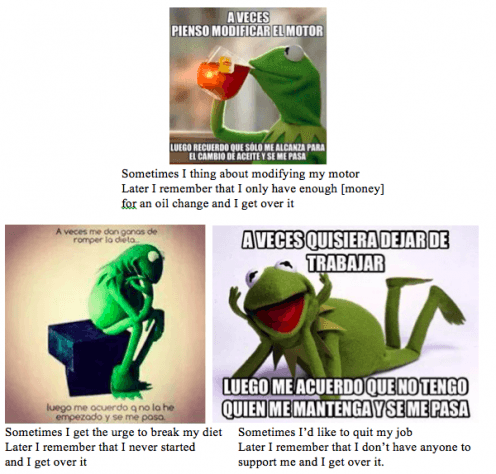
Image by Jolynna Sinanan
Although I left my field site in Trinidad on August 29, I have only just returned to Melbourne in the last week after nearly a year of being away. Last year, a large portion of field work was following the national issue of the large scale development project of the construction of a highway in the south of the country and the disputed section which will connect the areas of Debe to Mon Desir. My involvement started with covering the hunger strike of University of the West Indies lecturer Dr Kublalsingh, which lasted for 21 days. I watched this unfold by going to where Dr Kublalsingh was protesting, in front of the Prime Minister’s office, by following it on social media and by discussing it with informants in my field site, some 100kms away from where the highway is being constructed. Dr Kublalsingh ended his hunger strike when the Prime Minister agreed to reassess the decision to build that part of the highway and the Joint Constitutive Council (JCC) was funded by the government to review all the documents and agendas for and against constructing the section of the highway that would culminate in the Armstrong Report.
My involvement then deepened to the level of contributing to this state-sponsored review. I conducted a preliminary social impact assessment in the area and reviewed the reports from when the decision was made to go ahead with construction (in 2006) which I submitted to the Council. I concluded that no adequate social impact assessment had been conducted at the time and one should be, not just for that area, but for any area in which a large scale development project such as the construction of a highway is to take place. The JCC included at least five of my quotes in their final report.
Back in my field site, a town I have given the fictional name of El Mirador to protect the identities of the people who participated in my research, I was looking at how people were engaging with the issue on social media. Through my work with Dr Gabrielle Hosein, also from the University of the West Indies, we concluded that for those who aren’t in more ‘typical’ activist circles, of university students, musicians, artists and other urbanites, and more so, for those in country towns, being visibly, politically active and seriously engaging in national issues has social consequences of ridicule and alienation. It is very unusual for your average person in El Mirador to be politically active on Facebook.
Today, at the time of writing this blog entry, in Trinidad, Dr Kublalsingh is bedridden on day 47 of his second hunger strike, which he began on September 17. His reasons for this hunger strike is that the Prime Minister has not upheld her promise to adhere to the findings of the JCC report, undermining the council she assisted in founding and thereby undermining the efforts to build good governance in Trinidad. I have seen nothing on social media about Dr Kublalsingh or his second hunger strike on social media, apart from posts by the activist group he represents, the Highway Reroute Movement.
This situation is consistent with mine and Dr Hosein’s second insight that came out of the events of last year. A hunger strike is spectacular action, which makes the body a spectacle as an extreme form of resistance. But the power of the spectacle is in its transience, it holds power for only a short amount of time, a finite amount of time in which it disrupts the normal order. Similarly, Facebook is a spectacular space, a place to make things hyper visible. How many social media spectacles of causes gone viral can we name? Kony 2012? That video about sexual harassment? But the life of posts on social media are also finite. Sure, they exist in digital space forever, but people only care about them for a short amount of time. This obviously has bleak implications for Dr Kublalsingh’s actions.
A few members of the activist group have contacted me and implored my continued support. A few informants in El Mirador are wondering why I have kept silent this last month, when they know I have worked with and am friends with Dr Kublalsingh. My silence has been a mixture of having commitments to our project, which requires me to distance myself in order to adhere to the task of writing about the field and of having my immediate reality ruptured from being in Trinidad to being in Melbourne again.
The position of any anthropological researcher is not without contradiction (Sanford, 2006: 8). If we choose to take up Bourgois’ challenge ‘to venture into the ‘real world’ not just to ‘interview’ people but to actually participate in their daily life and to partake of their social and cultural reality’ (1990:45, quoted by Sanford, 2006: 6), we return with a mess of realities and experiences to come to terms with; our own and those of others. I will probably not see Dr Kublalsingh again. I feel an ethical obligation to uphold my integrity to the research in El Mirador but also to uphold my contribution to the Armstrong Report. This blog post has been a messy and inadequate attempt to do both.
References:
Bourgois, Philippe. 1990. ‘Confronting Anthropological Ethics: Ethnographic Lessons from Central America’, Journal of Peace Research, 27.1: 43-54.
Sanford, Victoria and Angel-Ajani, Asale (eds). 2006. Engaged Observer: Anthropology, Advocacy and Activism, New Brunswick, New Jersey and London: Rutgers University Press
Filed under Anthropology, Methodology, Politics, Trinidad
Tags: activism, anthropology of development, development, environment, ethics, Facebook, highway, political activism, social media
9 Comments »

 Close
Close















